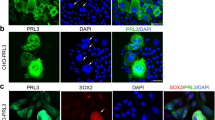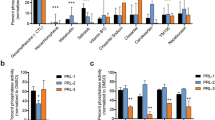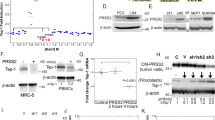Abstract
PRL-3, a protein tyrosine phosphatase (PTP), has a significant influence on the pathogenesis of various cancers with its overexpression significantly correlating with tumor invasion, metastasis and poor prognosis. It significantly affects tumor cell behavior through its involvement in cell proliferation, migration and metabolic processes. Furthermore, the interaction between PRL-3 and the tumor microenvironment characterized by its adaptability to stress and its role in metabolic reprogramming enhances tumor cell survival and dissemination. Targeted therapies against PRL-3, encompassing small molecule inhibitors and the monoclonal antibody PRL-3-zumab, have shown promise in clinical and preclinical studies, presenting new avenues for cancer treatment. In addition, innovative approaches such as CAAX motif-targeting agents and PRL-3 degradation strategies hold promise for developing more precise and effective interventions. This review explores PRL-3’s multifaceted roles across different tumor types and microenvironments, while discussing current and emerging therapeutic strategies aimed at exploiting its oncogenic potential.
This is a preview of subscription content, access via your institution
Access options
Subscribe to this journal
Receive 12 print issues and online access
$259.00 per year
only $21.58 per issue
Buy this article
- Purchase on SpringerLink
- Instant access to full article PDF
Prices may be subject to local taxes which are calculated during checkout





Similar content being viewed by others
References
Burnett G, Kennedy EP. The enzymatic phosphorylation of proteins. J Biol Chem. 1954;211:969–80.
Bilbrough T, Piemontese E, Seitz O. Dissecting the role of protein phosphorylation: A chemical biology toolbox. Chem Soc Rev. 2022;51:5691–730.
Stanford SM, Bottini N. Targeting protein phosphatases in cancer immunotherapy and autoimmune disorders. Nat Rev Drug Discov. 2023;22:273–94.
Alonso A, Sasin J, Bottini N, Friedberg I, Friedberg I, Osterman A, et al. Protein tyrosine phosphatases in the human genome. Cell. 2004;117:699–711.
Östman A, Hellberg C, Böhmer FD. Protein-tyrosine phosphatases and cancer. Nat Rev Cancer. 2006;6:307–20.
Saha S, Bardelli A, Buckhaults P, Velculescu VE, Rago C, St Croix B, et al. A phosphatase associated with metastasis of colorectal cancer. Science. 2001;294:1343–6.
Zeng Q, Hong W, Tan YH. Mouse PRL-2 and PRL-3, Two potentially prenylated protein tyrosine phosphatases homologous to PRL-1. Biochem Biophys Res Commun. 1998;244:421–7.
Zeng Q, Si X, Horstmann H, Xu Y, Hong W, Pallen CJ. Prenylation-dependent association of protein-tyrosine phosphatases PRL-1, -2, and -3 with the plasma membrane and the early endosome. J Biol Chem. 2000;275:21444–52.
Chia PL, Ang KH, Thura M, Zeng Q. PRL3 as a therapeutic target for novel cancer immunotherapy in multiple cancer types. Theranostics. 2023;13:1876–91.
Hardy S, Kostantin E, Hatzihristidis T, Zolotarov Y, Uetani N, Tremblay ML. Physiological and oncogenic roles of the PRL phosphatases. FEBS J. 2018;285:3886–908.
Matter WF, Estridge T, Zhang C, Belagaje R, Stancato L, Dixon J, et al. Role of PRL-3, a human muscle-specific tyrosine phosphatase, in angiotensin-II signaling. Biochem Biophys Res Commun. 2001;283:1061–8.
Tonks NK. PTP1B: From the sidelines to the front lines! FEBS Lett. 2003;546:140–8.
Song Y, Zhao M, Zhang H, Yu B. Double-edged roles of protein tyrosine phosphatase SHP2 in cancer and its inhibitors in clinical trials. Pharmacol Ther. 2022;230:107966.
Zinovjev K, Guénon P, Ramos-Guzmán CA, Ruiz-Pernía JJ, Laage D, Tuñón I. Activation and friction in enzymatic loop opening and closing dynamics. Nat Commun. 2024;15:2490.
Tonks NK. Protein tyrosine phosphatases: from genes, to function, to disease. Nat Rev Mol Cell Biol. 2006;7:833–46.
Rios P, Li X, Köhn M. Molecular mechanisms of the PRL phosphatases. FEBS J. 2013;280:505–24.
Tao Y, You W. The deubiquitinating enzyme USP4 functions as an oncoprotein in gastric cancer and mediates NF-κB signaling by regulating PRL-3 expression. Front Biosci Landmark Ed. 2022;27:286.
Miskad UA, Semba S, Kato H, Matsukawa Y, Kodama Y, Mizuuchi E, et al. High PRL-3 expression in human gastric cancer is a marker of metastasis and grades of malignancies: an in situ hybridization study. Virchows Arch. 2007;450:303–10.
Polato F, Codegoni A, Fruscio R, Perego P, Mangioni C, Saha S, et al. PRL-3 phosphatase is implicated in ovarian cancer growth. Clin Cancer Res. 2005;11:6835–9.
Ren T, Jiang B, Xing X, Dong B, Peng L, Meng L, et al. Prognostic significance of phosphatase of regenerating liver-3 expression in ovarian cancer. Pathol Oncol Res. 2009;15:555–60.
Ma Y, Li B. Expression of phosphatase of regenerating liver-3 in squamous cell carcinoma of the cervix. Med Oncol. 2011;28:775–80.
Ming J, Liu N, Gu Y, Qiu X, Wang EH. PRL-3 facilitates angiogenesis and metastasis by increasing ERK phosphorylation and up-regulating the levels and activities of Rho-A/C in lung cancer. Pathology. 2009;41:118–26.
Chen G, Zhang Z, Li J, Hu C, Gao D, Chen J, et al. Phosphatase regenerating liver 3 participates in integrinβ1/FAK-Src/MAPK signaling pathway and contributes to the regulation of malignant behaviors in hepatocellular carcinoma cells. J Gastrointest Oncol. 2023;14:863–73.
Xu Y, Zhu M, Zhang S, Liu H, Li T, Qin C. Expression and prognostic value of PRL-3 in human intrahepatic cholangiocarcinoma. Pathol Oncol Res. 2010;16:169–75.
Zhao W-B, Li Y, Liu X, Zhang L-Y, Wang X. Evaluation of PRL-3 expression, and its correlation with angiogenesis and invasion in hepatocellular carcinoma. Int J Mol Med. 2008;22:187–92.
Kong L, Li Q, Wang L, Liu Z, Sun T. The value and correlation between PRL‐3 expression and matrix metalloproteinase activity and expression in human gliomas. Neuropathology. 2007;27:516–21.
Zhou J, Wang S, Lu J, Li J, Ding Y. Over‐expression of phosphatase of regenerating liver‐3 correlates with tumor progression and poor prognosis in nasopharyngeal carcinoma. Int J Cancer. 2009;124:1879–86.
Liu YQ, Li HX, Lou X, Lei JY. Expression of phosphatase of regenerating liver 1 and 3 mRNA in esophageal squamous cell carcinoma. Arch Pathol Lab Med. 2008;132:1307–12.
Bardelli A, Saha S, Sager JA, Romans KE, Xin B, Markowitz SD, et al. PRL-3 expression in metastatic cancers. Clin Cancer Res. 2003;9:5607–15.
Radke I, Götte M, Kersting C, Mattsson B, Kiesel L, Wülfing P. Expression and prognostic impact of the protein tyrosine phosphatases PRL-1, PRL-2, and PRL-3 in breast cancer. Br J Cancer. 2006;95:347–54.
Laurent C, Valet F, Planque N, Silveri L, Maacha S, Anezo O, et al. High PTP4A3 phosphatase expression correlates with metastatic risk in uveal melanoma patients. Cancer Res. 2011;71:666–74.
Dong Q, Ding X, Chang B, Wang H, Wang A. PRL‐3 promotes migration and invasion and is associated with poor prognosis in salivary adenoid cystic carcinoma. J Oral Pathol Med. 2016;45:111–8.
Qu S, Liu B, Guo X, Shi H, Zhou M, Li L, et al. Independent oncogenic and therapeutic significance of phosphatase PRL‐3 in FLT3‐ITD–negative acute myeloid leukemia. Cancer. 2014;120:2130–41.
Xu J, Wu W, Tang Y, Lin Y, Xue Y, Hu J, et al. PRL-3 exerts oncogenic functions in myeloid leukemia cells via aberrant dephosphorylation of stathmin and activation of STAT3 signaling. Aging. 2019;11:7817–29.
Zhou L, Pei X, Zhang Y, Ning Y, Li L, Hu X, et al. Chk1 inhibition potently blocks STAT3 tyrosine705 phosphorylation, DNA-binding activity, and activation of downstream targets in human multiple myeloma cells. Mol Cancer Res MCR. 2022;20:456–67.
Chong PSY, Zhou J, Lim JSL, Hee YT, Chooi JY, Chung TH, et al. IL6 promotes a STAT3-PRL3 feedforward loop via SHP2 repression in multiple myeloma. Cancer Res. 2019;79:4679–88.
Broyl A, Hose D, Lokhorst H, De Knegt Y, Peeters J, Jauch A, et al. Gene expression profiling for molecular classification of multiple myeloma in newly diagnosed patients. Blood. 2010;116:2543–53.
Molleví DG, Aytes A, Berdiel M, Padullés L, Martínez-Iniesta M, Sanjuan X, et al. PRL-3 overexpression in epithelial cells is induced by surrounding stromal fibroblasts. Mol Cancer. 2009;8:46.
Lan Q, Lai W, Zeng Y, Liu L, Li S, Jin S, et al. CCL26 participates in the PRL-3-induced promotion of colorectal cancer invasion by stimulating tumor-associated macrophage infiltration. Mol Cancer Ther. 2018;17:276–89.
Xu H, Zeng Y, Liu L, Gao Q, Jin S, Lan Q, et al. PRL-3 improves colorectal cancer cell proliferation and invasion through IL-8 mediated glycolysis metabolism. Int J Oncol. 2017;51:1271–9.
Xing C, Lu XX, Guo PD, Shen T, Zhang S, He XS, et al. Ubiquitin-specific protease 4-mediated deubiquitination and stabilization of PRL-3 is required for potentiating colorectal oncogenesis. Cancer Res. 2016;76:83–95.
Funato Y, Yoshida A, Hirata Y, Hashizume O, Yamazaki D, Miki H. The oncogenic PRL protein causes acid addiction of cells by stimulating lysosomal exocytosis. Dev Cell. 2020;55:387–397.e8.
Raulet DH, Gasser S, Gowen BG, Deng W, Jung H. Regulation of ligands for the NKG2D activating receptor. Annu Rev Immunol. 2013;31:413–41.
Leung WH, Vong QP, Lin W, Bouck D, Wendt S, Sullivan E, et al. PRL-3 mediates the protein maturation of ULBP2 by regulating the tyrosine phosphorylation of HSP60. J Immunol Baltim Md. 2015;194:2930–41.
Liu C, Zhong W, Xia L, Fang C, Liu H, Liu X. A retrospective cohort study of clinical value of PRL-3 in stage III human colorectal cancer. Medicine. 2021;100:e25658.
Siegel RL, Miller KD, Fuchs HE, Jemal A. Cancer statistics, 2022. Ca Cancer J Clin. 2022;72:7–33.
Li Z, Cao Y, Jie Z, Liu Y, Li Y, Li J, et al. miR-495 and miR-551a inhibit the migration and invasion of human gastric cancer cells by directly interacting with PRL-3. Cancer Lett. 2012;323:41–7.
Zhang C, Tian W, Meng L, Qu L, Shou C. PRL-3 promotes gastric cancer migration and invasion through a NF-κB-HIF-1α-miR-210 axis. J Mol Med Berl Ger. 2016;94:401–15.
Turaga KK, Gamblin TC, Pappas S. Surgical treatment of peritoneal carcinomatosis from gastric cancer. Int J Surg Oncol. 2012;2012:405652.
Xiong J, Li Z, Zhang Y, Li D, Zhang G, Luo X, et al. PRL-3 promotes the peritoneal metastasis of gastric cancer through the PI3K/Akt signaling pathway by regulating PTEN. Oncol Rep. 2016;36:1819–28.
Zhang Y, Li Z, Fan X, Xiong J, Zhang G, Luo X, et al. PRL-3 promotes gastric cancer peritoneal metastasis via the PI3K/AKT signaling pathway in vitro and in vivo. Oncol Lett. 2018;15:9069–74.
Zhou Q, Zhou Q, Liu Q, He Z, Yan Y, Lin J, et al. PRL-3 facilitates hepatocellular carcinoma progression by co-amplifying with and activating FAK. Theranostics. 2020;10:10345–59.
Malard F, Mohty M. Acute lymphoblastic leukaemia. Lancet Lond Engl. 2020;395:1146–62.
Hjort MA, Abdollahi P, Vandsemb EN, Fenstad MH, Lund B, Slørdahl TS, et al. Phosphatase of regenerating liver-3 is expressed in acute lymphoblastic leukemia and mediates leukemic cell adhesion, migration and drug resistance. Oncotarget. 2017;9:3549–61.
Garcia EG, Veloso A, Oliveira ML, Allen JR, Loontiens S, Brunson D, et al. PRL3 enhances T-cell acute lymphoblastic leukemia growth through suppressing T-cell signaling pathways and apoptosis. Leukemia. 2021;35:679–90.
Chong PSY, Zhou J, Chooi JY, Chan ZL, Toh SHM, Tan TZ, et al. Non-canonical activation of β-catenin by PRL-3 phosphatase in acute myeloid leukemia. Oncogene. 2019;38:1508–19.
Zhou J, Toh SHM, Chan ZL, Quah JY, Chooi JY, Tan TZ, et al. A loss-of-function genetic screening reveals synergistic targeting of AKT/mTOR and WTN/β-catenin pathways for treatment of AML with high PRL-3 phosphatase. J Hematol Oncol J Hematol Oncol. 2018;11:36.
Chen X, Rong D, Cai W, Tong X, Wang H. The combination of PRL-3 inhibitor with sorafenib synergistically promotes AML apoptosis. Neoplasma. 2021;68:832–41.
Hjort MA, Hov H, Abdollahi P, Vandsemb EN, Fagerli UM, Lund B, et al. Phosphatase of regenerating liver-3 (PRL-3) is overexpressed in classical Hodgkin lymphoma and promotes survival and migration. Exp Hematol Oncol. 2018;7:8.
Chong PSY, Chng WJ, de Mel S. STAT3: a promising therapeutic target in multiple myeloma. Cancers. 2019;11:731.
Abdollahi, Vandsemb P, Elsaadi EN, Røst S, Yang R LM, Hjort MA, et al. Phosphatase of regenerating liver-3 regulates cancer cell metabolism in multiple myeloma. FASEB J Publ Fed Am Soc Exp Biol. 2021;35:e21344.
Louis DN, Perry A, Reifenberger G, von Deimling A, Figarella-Branger D, Cavenee WK, et al. The 2016 World Health Organization classification of tumors of the central nervous system: a summary. Acta Neuropathol. 2016;131:803–20.
Mu N, Gu J, Liu N, Xue X, Shu Z, Zhang K, et al. PRL-3 is a potential glioblastoma prognostic marker and promotes glioblastoma progression by enhancing MMP7 through the ERK and JNK pathways. Theranostics. 2018;8:1527–39.
Foy M, Anézo O, Saule S, Planque N. PRL-3/PTP4A3 phosphatase regulates integrin Β1 in adhesion structures during migration of human ocular melanoma cells. Exp Cell Res. 2017;353:88–99.
McQueeney KE, Salamoun JM, Burnett JC, Barabutis N, Pekic P, Lewandowski SL, et al. Targeting ovarian cancer and endothelium with an allosteric PTP4A3 phosphatase inhibitor. Oncotarget. 2018;9:8223–40.
Lazo JS, Isbell KN, Vasa SA, Llaneza DC, Rastelli EJ, Wipf P, et al. Disruption of ovarian cancer STAT3 and P38 signaling with a small-molecule inhibitor of PTP4A3 phosphatase. J Pharmacol Exp Ther. 2023;384:429–38.
Shi Y, Xu S, Ngoi NYL, Zeng Q, Ye Z. PRL-3 Dephosphorylates P38 MAPK to promote cell survival under stress. Free Radic Biol Med. 2021;177:72–87.
Radke I, Götte M, Smollich M, Scharle N, Kiesel L, Wülfing P. Expression of PRL-3 regulates proliferation and invasion of breast cancer cells in vitro. Arch Gynecol Obstet. 2017;296:1153–60.
Xie H, Wang H. PRL-3 promotes breast cancer progression by downregulating P14(ARF)-mediated P53 expression.PRL-3 promotes breast cancer progression by downregulating P14(ARF)-mediated P53 expression. Oncol Lett. 2018;15:2795–800.
Gari HH, Gearheart CM, Fosmire S, DeGala GD, Fan Z, Torkko KC, et al. Genome-wide functional genetic screen with the anticancer agent AMPI-109 identifies PRL-3 as an oncogenic driver in triple-negative breast cancers. Oncotarget. 2016;7:15757–71.
Gari HH, DeGala GD, Ray R, Lucia MS, Lambert JR. PRL-3 engages the focal adhesion pathway in triple-negative breast cancer cells to alter actin structure and substrate adhesion properties critical for cell migration and invasion. Cancer Lett. 2016;380:505–12.
Gari HH, DeGala GD, Lucia MS, Lambert JR. Loss of the oncogenic phosphatase PRL-3 promotes a TNF-R1 feedback loop that mediates triple-negative breast cancer growth. Oncogenesis. 2016;5:e255.
Ye Z, Ng CP, Liu H, Bao Q, Xu S, Zu D, et al. PRL1 and PRL3 promote macropinocytosis via its lipid phosphatase activity. Theranostics. 2024;14:3423–38.
Yamashita S, Masuda Y, Matsumoto K, Okumura Y, Matsuzaki H, Kurizaki T, et al. Down-regulation of the human PRL-3 gene is associated with the metastasis of primary non-small cell lung cancer. Ann Thorac Cardiovasc Surg J Assoc Thorac Cardiovasc Surg Asia. 2007;13:236–9.
Lin SY, Lee YX, Yu SL, Chang GC, Chen JJW. Phosphatase of regenerating liver-3 inhibits invasiveness and proliferation in non-small cell lung cancer by regulating the epithelial-mesenchymal transition. Oncotarget. 2016;7:21799–811.
Ahn JH, Kim SJ, Park WS, Cho SY, Ha JD, Kim SS, et al. Synthesis and biological evaluation of rhodanine derivatives as PRL-3 inhibitors. Bioorg Med Chem Lett. 2006;16:2996–9.
Mendgen T, Steuer C, Klein CD. Privileged scaffolds or promiscuous binders: a comparative study on rhodanines and related heterocycles in medicinal chemistry. J Med Chem. 2012;55:743–53.
Daouti S, Li W, Qian H, Huang KS, Holmgren J, Levin W, et al. A selective phosphatase of regenerating liver phosphatase inhibitor suppresses tumor cell anchorage-independent growth by a novel mechanism involving p130Cas cleavage. Cancer Res. 2008;68:1162–9.
Salamoun JM, McQueeney KE, Patil K, Geib SJ, Sharlow ER, Lazo JS, et al. Photooxygenation of an amino-thienopyridone yields a more potent PTP4A3 inhibitor. Org Biomol Chem. 2016;14:6398–402.
Rivas DR, Dela Cerna MVC, Smith CN, Sampathi S, Patty BG, Lee D, et al. A screen of FDA-approved drugs identifies inhibitors of protein tyrosine phosphatase 4A3 (PTP4A3 or PRL-3). Sci Rep. 2021;11:10302.
Bennett GM, Starczewski J, dela Cerna MVC. In silico identification of putative druggable pockets in PRL3, a significant oncology target. Biochem Biophys Rep. 2024;39:101767.
Thura M, Al-Aidaroos AQO, Yong WP, Kono K, Gupta A, Lin YB, et al. PRL3-Zumab, a first-in-class humanized antibody for cancer therapy. JCI Insight. 2016;1:e87607.
Thura M, Al-Aidaroos AQ, Gupta A, Chee CE, Lee SC, Hui KM, et al. PRL3-Zumab as an immunotherapy to inhibit tumors expressing PRL3 oncoprotein. Nat Commun. 2019;10:2484.
Chee CE, Ooi M, Lee SC, Sundar R, Heong V, Yong WP, et al. A phase I, first-in-human study of PRL3-Zumab in advanced, refractory solid tumors and hematological malignancies. Target Oncol. 2023;18:391–402.
Loh AHP, Thura M, Gupta A, Tan SH, Kuan KKY, Ang KH, et al. Exploiting frequent and specific expression of PRL3 in pediatric solid tumors for first-in-child use of PRL3-Zumab humanized antibody. Mol Ther Oncolytics. 2023;30:153–66.
Thura M, Ye Z, Al-Aidaroos AQ, Xiong Q, Ong JY, Gupta A, et al. PRL3 induces polypoid giant cancer cells eliminated by PRL3-Zumab to reduce tumor relapse. Commun Biol. 2021;4:923.
Sun S, Meng L, Xing X, Li N, Song Q, Qiao D, et al. Anti-PRL-3 monoclonal antibody inhibits the growth and metastasis of colorectal adenocarcinoma. J Cancer. 2023;14:2585–95.
Wang J, Yao X, Huang J. New tricks for human farnesyltransferase inhibitor: cancer and beyond. MedChemComm. 2017;8:841–54.
Funato Y, Hashizume O, Miki H. Phosphatase‐independent role of phosphatase of regenerating liver in cancer progression. Cancer Sci. 2022;114:25–33.
Acknowledgements
This work was supported by Shanghai Science and Technology Development Funds (24YF2755300), Guangdong High-level New R&D Institute (2019B090904008), and Guangdong High-level Innovative Research Institute (2021B0909050003). Additionally, we are grateful for the insightful exchanges with our lab colleagues.
Author information
Authors and Affiliations
Corresponding authors
Ethics declarations
Competing interests
The authors declare no competing interests.
Additional information
Publisher’s note Springer Nature remains neutral with regard to jurisdictional claims in published maps and institutional affiliations.
Rights and permissions
Springer Nature or its licensor (e.g. a society or other partner) holds exclusive rights to this article under a publishing agreement with the author(s) or other rightsholder(s); author self-archiving of the accepted manuscript version of this article is solely governed by the terms of such publishing agreement and applicable law.
About this article
Cite this article
Cao, Zt., Mao, Jl., Huang, Cy. et al. PRL-3: unveiling a new horizon in cancer therapy. Acta Pharmacol Sin 46, 2597–2607 (2025). https://doi.org/10.1038/s41401-025-01563-1
Received:
Accepted:
Published:
Issue date:
DOI: https://doi.org/10.1038/s41401-025-01563-1



